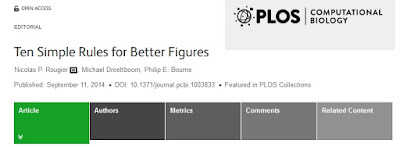Avanzando un poco más que lo de la variable representada y los ejes, y por cambiar de autor, un decálogo:
Un artículo interesante y práctico. Con 10 ideas sencillas, cada una bien explicada e ilustrada con figuras claras. Está en libre acceso AQUÍ. La introducción y la lista de las reglas es:
Scientific visualization is classically defined as the process of
graphically displaying scientific data. However, this process is far
from direct or automatic. There are so many different ways to represent
the same data: scatter plots, linear plots, bar plots, and pie charts,
to name just a few. Furthermore, the same data, using the same type of
plot, may be perceived very differently depending on who is looking at
the figure. A more accurate definition for scientific visualization
would be a graphical interface between people and data. In this short
article, we do not pretend to explain everything about this interface;
rather, see [1], [2] for introductory work. Instead we aim to provide a
basic set of rules to improve figure design and to explain some of the
common pitfalls.
Rule 1: Know Your Audience
Rule 2: Identify Your Message
Rule 3: Adapt the Figure to the Support Medium
Rule 4: Captions Are Not Optional
Rule 5: Do Not Trust the Defaults
Rule 6: Use Color Effectively
Rule 7: Do Not Mislead the Reader
Rule 8: Avoid “Chartjunk”
Rule 9: Message Trumps Beauty
Rule 10: Get the Right Tool
[1] Tufte EG (1983) The Visual Display of Quantitative Information. Cheshire, Connecticut: Graphics Press.
[2] Doumont JL (2009) Trees, maps, and theorems. Brussels: Principiae.
